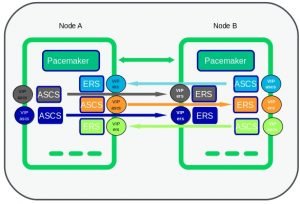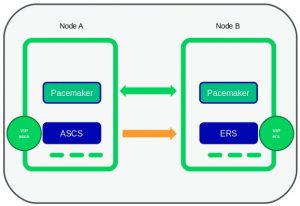
- SAP Community
- Products and Technology
- Enterprise Resource Planning
- ERP Blogs by SAP
- SAP Workloads going Green
Enterprise Resource Planning Blogs by SAP
Get insights and updates about cloud ERP and RISE with SAP, SAP S/4HANA and SAP S/4HANA Cloud, and more enterprise management capabilities with SAP blog posts.
Turn on suggestions
Auto-suggest helps you quickly narrow down your search results by suggesting possible matches as you type.
Showing results for
berndschubert
Explorer
Options
- Subscribe to RSS Feed
- Mark as New
- Mark as Read
- Bookmark
- Subscribe
- Printer Friendly Page
- Report Inappropriate Content
12-17-2019
3:45 PM
How to add more SAP instances to an existing SUSE cluster for S/4HANA or NetWeaver?
Back from SAP TechEd India I was able to continue my work on a new Best Practices document for making SAP workloads highly available. We received great feedback from SAP TechEd, SAPPHIRE and SUSECON this year and we’re doing our best take account of this feedback into continuously improving our Best Practices guides for our customers and partners.
I would also like to announce a new upcoming Best Practice guide for next year (2020) which will describe how to extend the SUSE HA cluster configuration with more than one SAP instance or SAP HANA DB. Here’s a small sneak preview for you of what’s coming. Since we don’t have a formal name yet we’ll just call it “multi-SID paper” here. This fits nicely into the slogan “SAP go green” in multiple ways. Firstly, use compute resources much more efficient. Secondly, using SUSE as OS to install the SAP application on top of it.
Running more than one S/4HANA or NetWeaver central instances in the same cluster!
For SAP central instances (ASCS/ERS) we have published multiple Best Practices:
https://documentation.suse.com/sbp/all/single-html/SAP_HA740_SetupGuide_AWS/
sap_netweaver_availability_cluster_740_setup_guide
https://documentation.suse.com/sbp/all/single-html/SAP_S4HA10_SetupGuide-SLE12/
https://documentation.suse.com/sbp/all/single-html/SAP_S4HA10_SetupGuide-SLE15/
Such a cluster looks like this simplified picture:
The question which has reached us is if we would support like the setup below?

The answer is simple: Yes we do.
What could you expect in 2020 for your SAP workloads?
Therefore we started together with Azure to prove and verify multiple scenarios for SAP central instances running in one SUSE HA cluster. The document is mostly finished and is currently in a final draft status. We still need to do some chapter restructuring and adding necessary general information before we can publish it though.
Examples topics that we will cover:
- Multi-SID setups for ENSA1 in a two node cluster
- Multi-SID setups for ENSA1 in a multi node cluster
- Multi-SID setups for ENSA2 in a two node cluster
- Multi-SID setups for ENSA2 in a multi node cluster
- Multi-SID setups for ENSA1 and ENSA2 in a two node cluster
- Multi-SID setups for ENSA1 and ENSA2 in a multi node cluster
- Multiple HANA SR DB pairs running in one cluster (not planed for the first release)
As you may know from all our other documentation this will be freely and openly available on our SUSE Best Practices website. In other words the SUSE “generic” Best Practice can be easily adapted to all infrastructure platforms. As a result most of our partner will adapt this and provide their own documentation or have a joint documentation with us. In summary the new paper describes the additional step needed to extend a running SUSE HA cluster for ASCS / ERS with additional installed ASCS / ERS instances. In other words you will see that the guide is repeating the steps which we have done for the first instance with less adaptions. In short I hope this guide will clearly allow you to differentiate between the points for the first instance and the new points you should take care of for the additional instances.
This is Bernd for SAP LinuxLab St. Leon-Rot Germany
- SAP Managed Tags:
- SUSE Linux Enterprise Server,
- SAP HANA,
- SAP NetWeaver,
- SAP NetWeaver Application Server,
- SAP S/4HANA
Labels:
2 Comments
You must be a registered user to add a comment. If you've already registered, sign in. Otherwise, register and sign in.
Labels in this area
-
Artificial Intelligence (AI)
1 -
Business Trends
363 -
Business Trends
21 -
Customer COE Basics and Fundamentals
1 -
Digital Transformation with Cloud ERP (DT)
1 -
Event Information
461 -
Event Information
24 -
Expert Insights
114 -
Expert Insights
154 -
General
1 -
Governance and Organization
1 -
Introduction
1 -
Life at SAP
415 -
Life at SAP
2 -
Product Updates
4,685 -
Product Updates
216 -
Roadmap and Strategy
1 -
Technology Updates
1,502 -
Technology Updates
89
Related Content
- SAP S/4HANA Cloud, public edition, ABAP Environment Case 8: Material Shelf Life Management in Enterprise Resource Planning Blogs by SAP
- FAQ on Upgrading SAP S/4HANA Cloud Public Edition in Enterprise Resource Planning Blogs by SAP
- What is the complete list of function restrictions during software update? in Enterprise Resource Planning Q&A
- Boost SCM Efficiency: Mat. Shelf Life Mgmt App Empowers Intelligent Decision-Making for Enterprises in Enterprise Resource Planning Blogs by SAP
- FireFighter ID login issue - FFID Status is in Red in Enterprise Resource Planning Blogs by Members
Top kudoed authors
| User | Count |
|---|---|
| 12 | |
| 11 | |
| 8 | |
| 6 | |
| 6 | |
| 4 | |
| 4 | |
| 4 | |
| 3 | |
| 3 |
